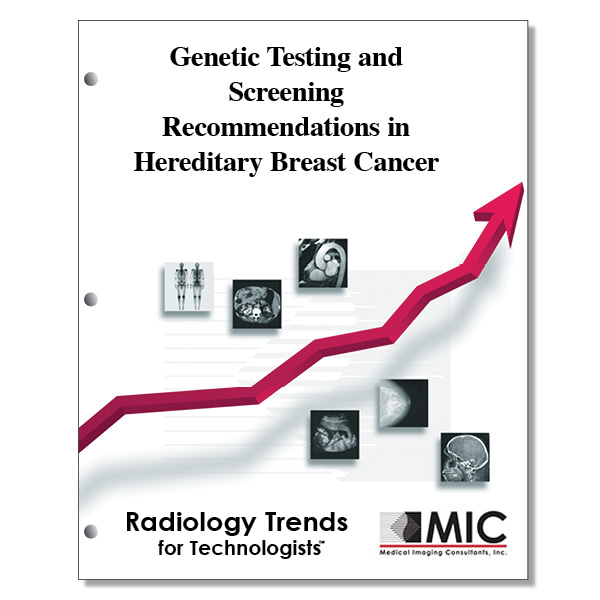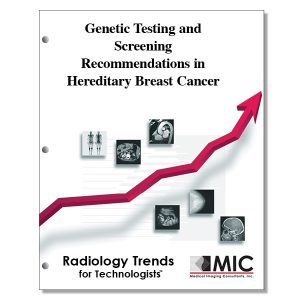

Genetic Testing and Screening Recommendations in Hereditary Breast Cancer
A review of genetic counseling, including the use of risk assessment models; the process of genetic testing; and the various gene mutations associated with an increased risk of breast cancer.
Course ID: Q00637 Category: Radiology Trends for Technologists Modalities: Mammography, Radiation Therapy3.0 |
Satisfaction Guarantee |
$34.00
- Targeted CE
- Outline
- Objectives
Targeted CE per ARRT’s Discipline, Category, and Subcategory classification:
[Note: Discipline-specific Targeted CE credits may be less than the total Category A credits approved for this course.]
Breast Sonography: 1.50
Patient Care: 1.00
Patient Interactions and Management: 1.00
Procedures: 0.50
Pathology: 0.50
Mammography: 1.50
Patient Care: 1.00
Patient Interactions and Management: 1.00
Procedures: 0.50
Anatomy, Physiology, and Pathology: 0.50
Magnetic Resonance Imaging: 0.50
Procedures: 0.50
Body: 0.50
Registered Radiologist Assistant: 1.50
Procedures: 1.50
Thoracic Section: 1.50
Sonography: 0.50
Procedures: 0.50
Superficial Structures and Other Sonographic Procedures: 0.50
Radiation Therapy: 1.50
Patient Care: 1.00
Patient and Medical Record Management: 1.00
Procedures: 0.50
Treatment Sites and Tumors: 0.50
Outline
- Introduction
- Pretest Genetic Counseling
- Commonly Used Risk Assessment Models
- Gail and Claus Models
- Tyrer-Cuzick Model
- BRCA Mutation Probability Models
- Other Considerations
- Selecting a Model
- Financial Costs
- Privacy and Discrimination Concerns
- Genetic Testing and Posttest Counseling
- High-Risk Genes
- BRCA1 and BRCA2
- Screening, Risk Management, and Treatment Implications
- TP53
- Screening, Risk Management, and Treatment Implications
- PTEN
- Screening, Risk Management, and Treatment Implications
- CDH1
- Screening, Risk Management, and Treatment Implications
- STK11
- Screening, Risk Management, and Treatment Implications
- ATM
- Screening, Risk Management, and Treatment Implications
- CHEK2
- Screening, Risk Management, and Treatment Implications
- PALB2
- Screening, Risk Management, and Treatment Implications
- Lynch Syndrome
- Screening, Risk Management, and Treatment Implications
- BRCA1 and BRCA2
- Additional Imaging Characteristics of Hereditary Breast Cancer
- Conclusion
Objectives
Upon completion of this course, students will:
- state the estimated number of women that will develop breast cancer in their lifetime
- list examples of enhanced screening for breast cancer
- list criteria for genetic counseling referral per the National Comprehensive Cancer Network
- state which gene mutations are most commonly associated with increased risk of breast cancer
- differentiate between personal and genetic variables when evaluating for breast cancer
- state when the Gail risk assessment model was designed
- state what the Gail risk assessment model is based on
- recall how many questions are on the Gail risk assessment model
- state who developed the Claus risk assessment model
- list the factors used for breast cancer risk assessment in the Claus model
- list the breast cancer risk assessment models that predict a patient’s risk of carrying the BRCA1 and BRCA2 mutation
- choose the BRCA mutation probability model that addresses the European and Ashkenazi Jewish population
- state which breast cancer risk model includes familial risks beyond those in second-degree relatives
- list the key components that geneticists can use to help determine which risk model is appropriate for a specific patient
- choose the most consistently accurate model for breast cancer risk prediction
- state what patient population has BRCA1 and BRCA2 mutation testing covered by Medicare
- state the month and year the U.S. Food and Drug Administration approved the first direct-to-consumer BRCA test by 23and Me
- choose the act that prevents health insurers from using genetic information to make policy decisions and employers from using genetic information in employment decisions
- list the multigene sequencing panels that include high-risk genes for developing breast cancer
- choose the high-risk gene that is associated with hereditary diffuse genetic cancer
- list the possible outcomes of genetic testing
- define a true negative genetic testing result
- state the percent of breast cancer cases that are caused by the BRCA1 and BRCA2 mutation
- choose the location of the BRCA2 gene
- choose the approximate amount of BRCA gene mutations that have been identified
- state the average age of breast cancer onset for BRCA gene mutation carriers
- state the approximate percent of BRCA2 mutation carriers that will develop breast cancer by the age of 70
- state the sensitivity of mammography for the detection of breast cancer in patients with a BRCA mutation
- list the factors associated with cancers in patients with BRCA1 mutations as compared with those that manifest sporadically in the general population
- understand the implications of a patient’s family history of cancer
- state the average age of breast cancer diagnosis in male BRCA-mutation carriers
- state the chromosome location for TP53
- state the most common cancer in patients with Cowden syndrome
- state the average age of diagnosis for hereditary diffuse gastric cancer
- describe the most common location for hamartomatous polyps
- state the mean age for diagnosis of Peutz-Jeghers syndrome
- state the overall lifetime risk of breast cancer in patients with a single ATM mutation
- recall the lifetime risk of breast cancer for patients with the CHEK2 mutation
- recall the additional common cancer in patients with a single PALB2 mutation
- list the cancers associated with Lynch syndrome
